coolant temperature SSANGYONG KORANDO 2012 Service Manual
[x] Cancel search | Manufacturer: SSANGYONG, Model Year: 2012, Model line: KORANDO, Model: SSANGYONG KORANDO 2012Pages: 1082, PDF Size: 96.1 MB
Page 100 of 1082
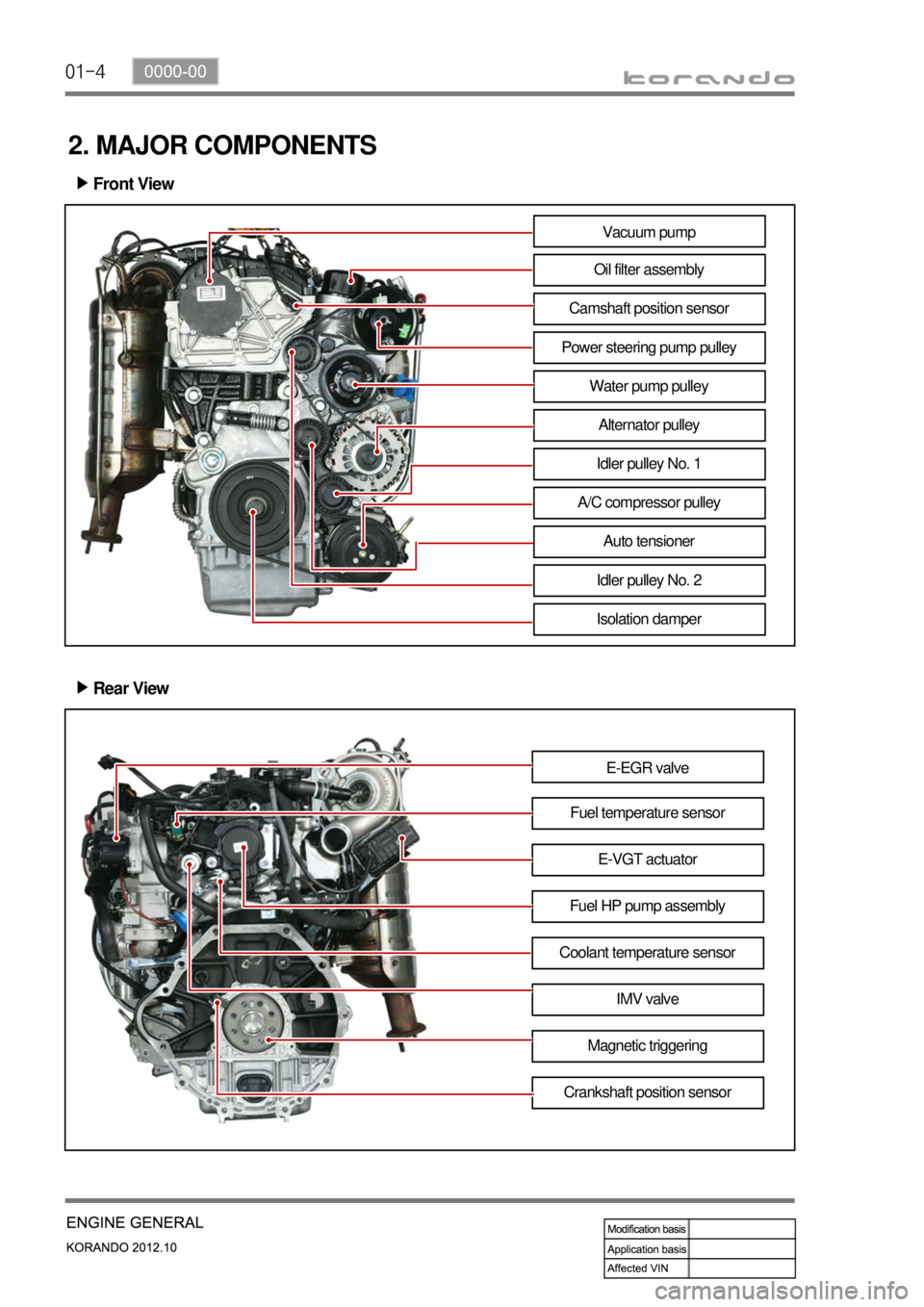
01-4
2. MAJOR COMPONENTS
Front View ▶
Vacuum pump
Oil filter assembly
Camshaft position sensor
Power steering pump pulley
Water pump pulley
Alternator pulley
Idler pulley No. 1
A/C compressor pulley
Auto tensioner
Idler pulley No. 2
Isolation damper
Rear View ▶
E-EGR valve
Fuel temperature sensor
Fuel HP pump assemblyE-VGT actuator
Coolant temperature sensor
IMV valve
Magnetic triggering
Crankshaft position sensor
Page 111 of 1082
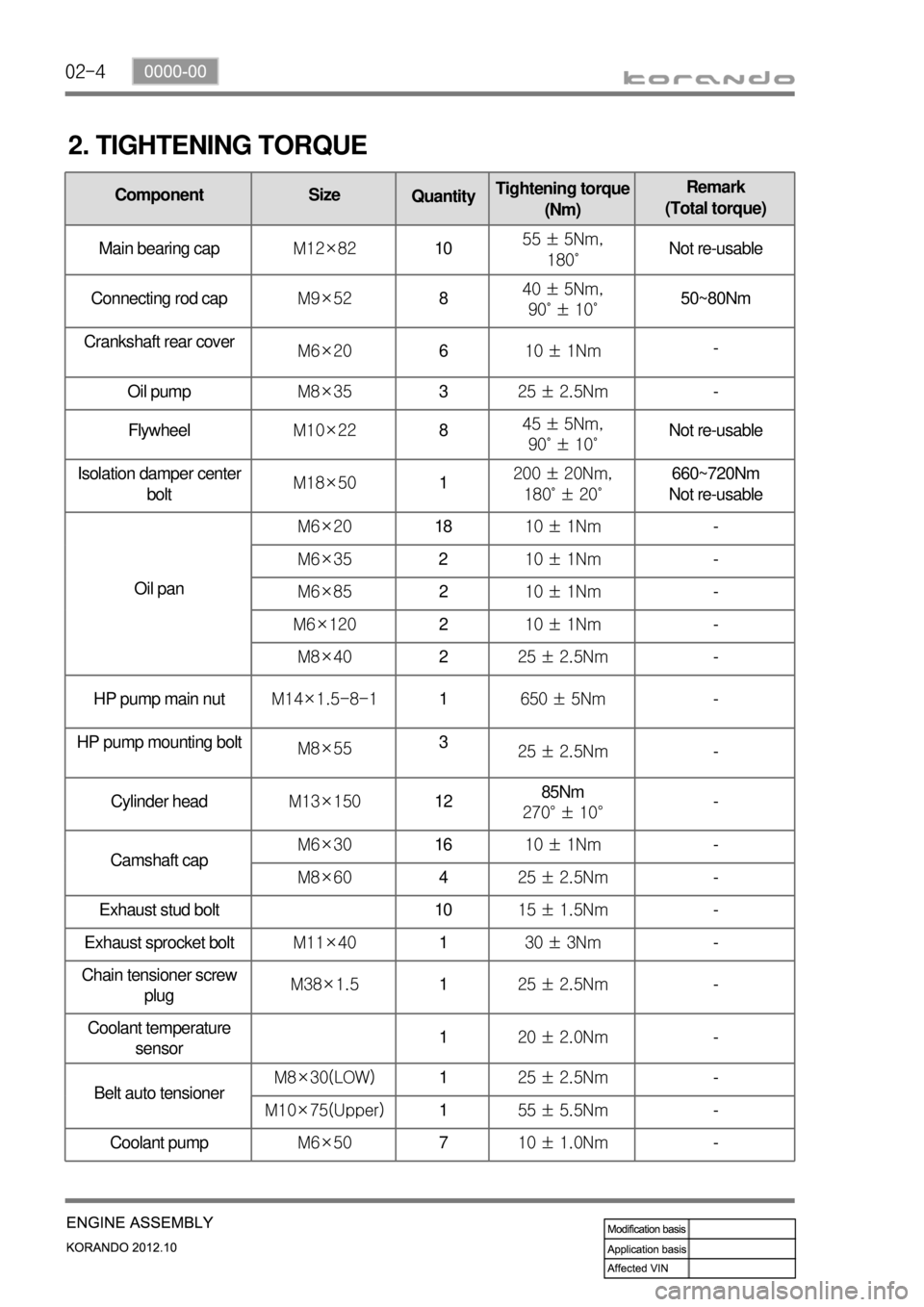
02-4
2. TIGHTENING TORQUE
Component Size
QuantityTightening torque
(Nm)Remark
(Total torque)
Main bearing capM12×821055 ± 5Nm,
180˚Not re-usable
Connecting rod capM9×52840 ± 5Nm,
90˚ ± 10˚50~80Nm
Crankshaft rear cover
M6×20610 ± 1Nm-
Oil pumpM8×35325 ± 2.5Nm-
FlywheelM10×22845 ± 5Nm,
90˚ ± 10˚Not re-usable
Isolation damper center
boltM18×501200 ± 20Nm,
180˚ ± 20˚660~720Nm
Not re-usable
Oil panM6×201810 ± 1Nm-
M6×35210 ± 1Nm-
M6×85210 ± 1Nm-
M6×120210 ± 1Nm-
M8×40225 ± 2.5Nm-
HP pump main nutM14×1.5-8-11650 ± 5Nm-
HP pump mounting bolt
M8×553
25 ± 2.5Nm-
Cylinder headM13×1501285Nm
270° ± 10°-
Camshaft capM6×301610 ± 1Nm-
M8×60425 ± 2.5Nm-
Exhaust stud bolt 1015 ± 1.5Nm-
Exhaust sprocket boltM11×40130 ± 3Nm-
Chain tensioner screw
plugM38×1.5125 ± 2.5Nm
-
Coolant temperature
sensor120 ± 2.0Nm-
Belt auto tensionerM8×30(LOW)125 ± 2.5Nm-
M10×75(Upper)155 ± 5.5Nm-
Coolant pumpM6×50710 ± 1.0Nm-
Page 152 of 1082
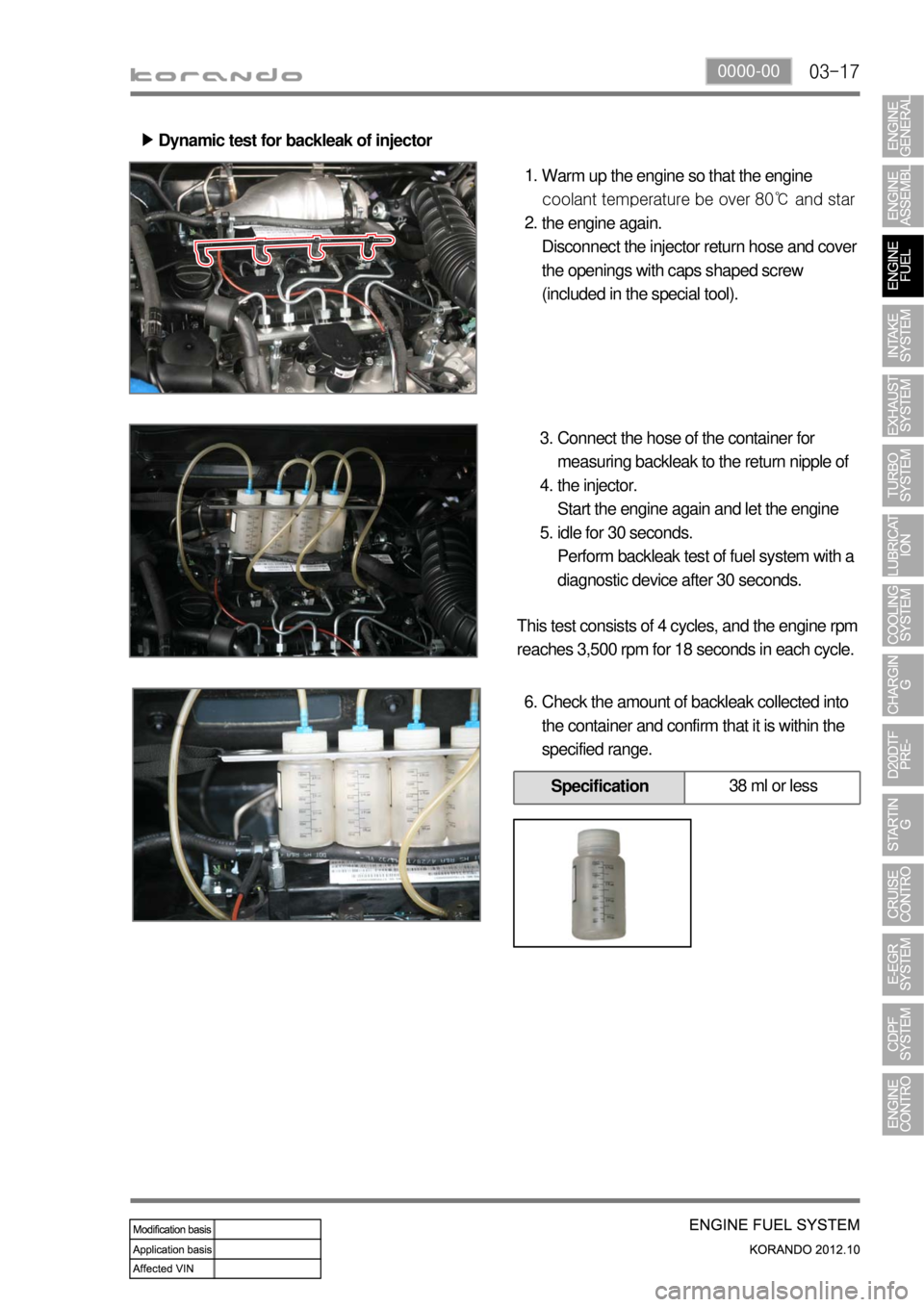
03-170000-00
Dynamic test for backleak of injector ▶
Warm up the engine so that the engine
coolant temperature be over 80℃ and star
the engine again.
Disconnect the injector return hose and cover
the openings with caps shaped screw
(included in the special tool). 1.
2.
Connect the hose of the container for
measuring backleak to the return nipple of
the injector.
Start the engine again and let the engine
idle for 30 seconds.
Perform backleak test of fuel system with a
diagnostic device after 30 seconds. 3.
4.
5.
This test consists of 4 cycles, and the engine rpm
reaches 3,500 rpm for 18 seconds in each cycle.
Check the amount of backleak collected into
the container and confirm that it is within the
specified range. 6.
Specification38 ml or less
Page 163 of 1082
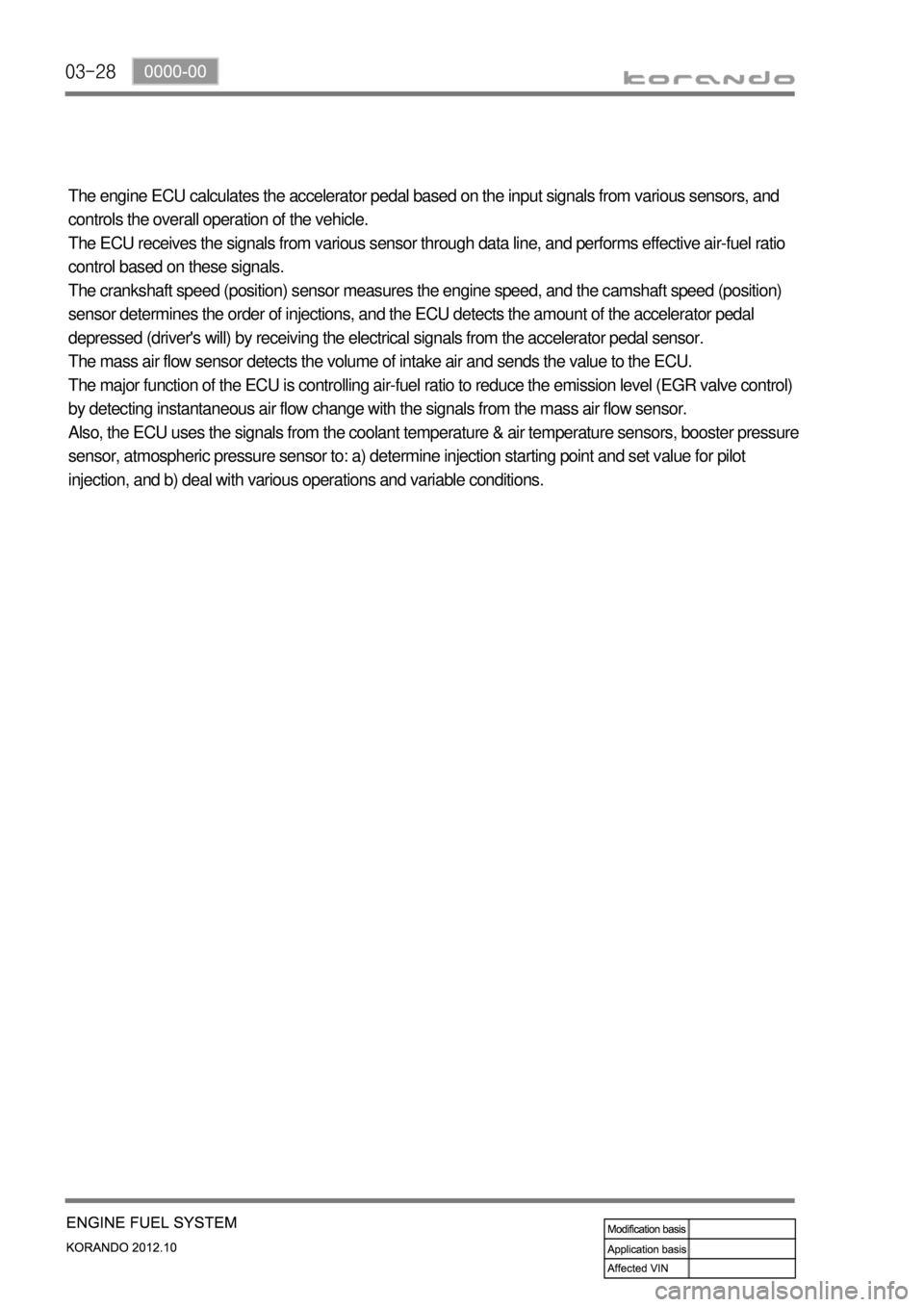
03-28
The engine ECU calculates the accelerator pedal based on the input signals from various sensors, and
controls the overall operation of the vehicle.
The ECU receives the signals from various sensor through data line, and performs effective air-fuel ratio
control based on these signals.
The crankshaft speed (position) sensor measures the engine speed, and the camshaft speed (position)
sensor determines the order of injections, and the ECU detects the amount of the accelerator pedal
depressed (driver's will) by receiving the electrical signals from the accelerator pedal sensor.
The mass air flow sensor detects the volume of intake air and sends the value to the ECU.
The major function of the ECU is controlling air-fuel ratio to reduce the emission level (EGR valve control)
by detecting instantaneous air flow change with the signals from the mass air flow sensor.
Also, the ECU uses the signals from the coolant temperature & air temperature sensors, booster pressure
sensor, atmospheric pressure sensor to: a) determine injection starting point and set value for pilot
injection, and b) deal with various operations and variable conditions.
Page 196 of 1082
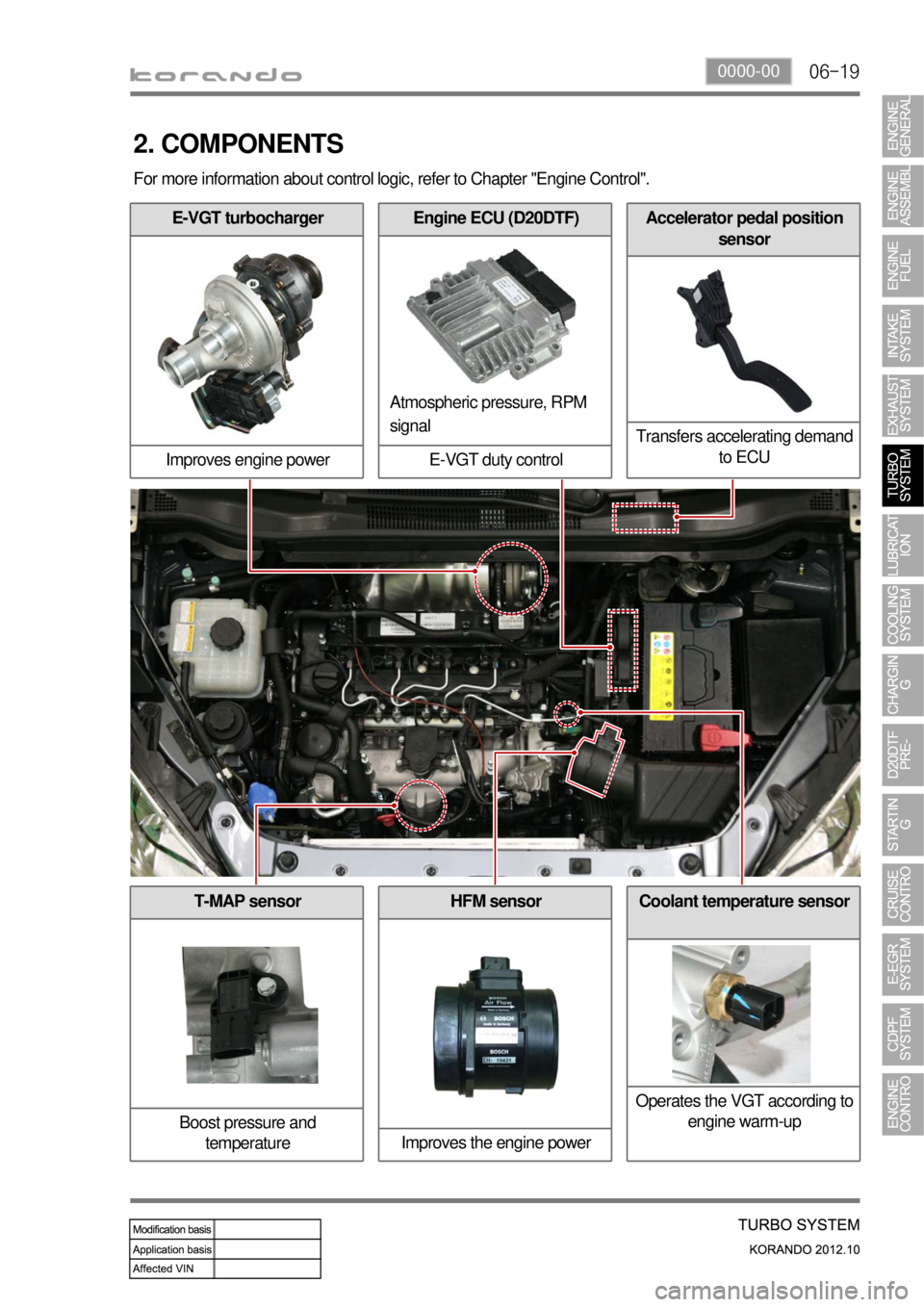
06-190000-00
T-MAP sensor
Boost pressure and
temperature
E-VGT turbocharger
Improves engine power
2. COMPONENTS
Engine ECU (D20DTF)
E-VGT duty controlAccelerator pedal position
sensor
Transfers accelerating demand
to ECU
Atmospheric pressure, RPM
signal
HFM sensor
Improves the engine powerCoolant temperature sensor
Operates the VGT according to
engine warm-up
For more information about control logic, refer to Chapter "Engine Control".
Page 206 of 1082
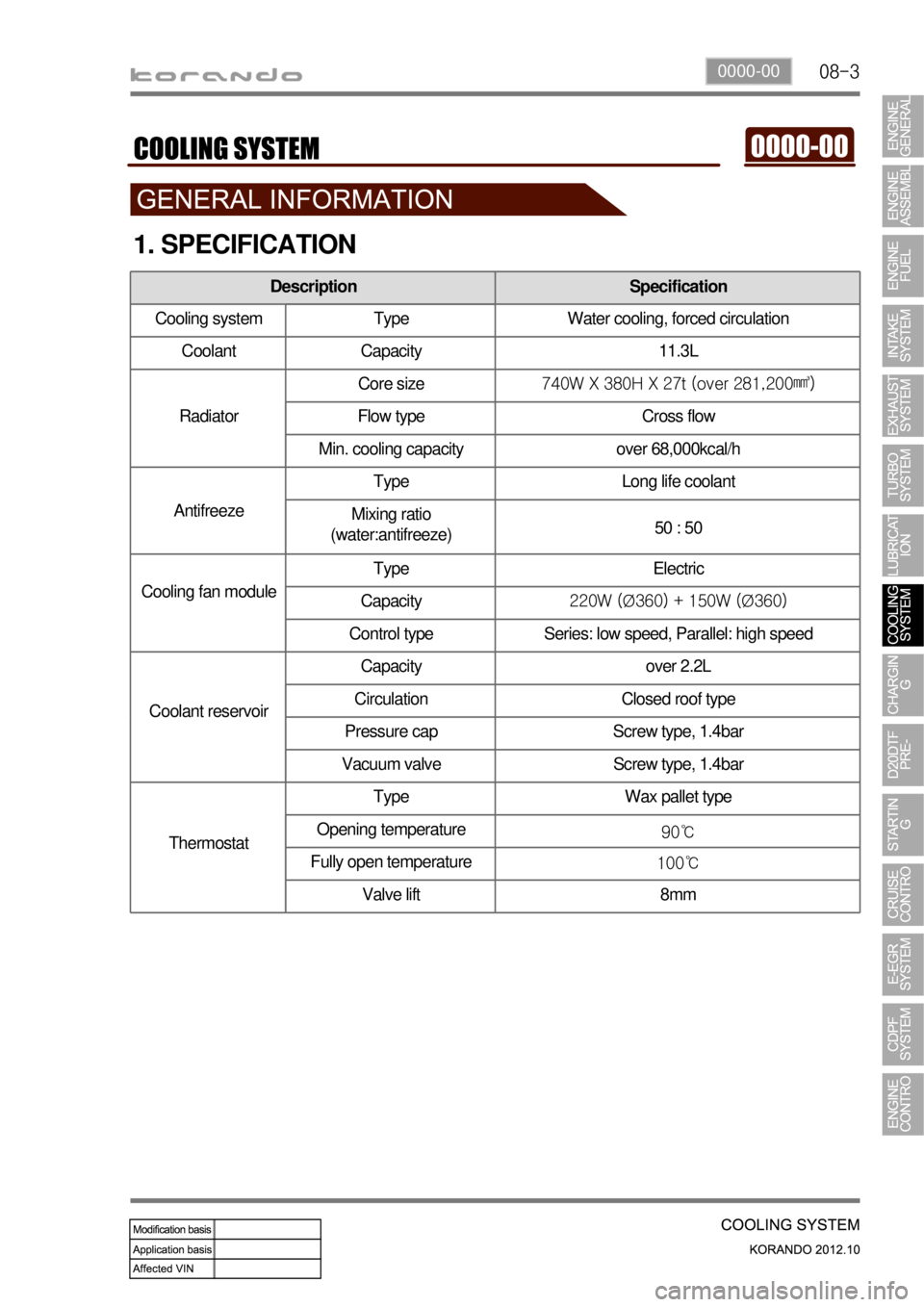
08-30000-00
1. SPECIFICATION
Description Specification
Cooling system Type Water cooling, forced circulation
Coolant Capacity 11.3L
RadiatorCore size740W X 380H X 27t (over 281,200㎣)
Flow type Cross flow
Min. cooling capacity over 68,000kcal/h
AntifreezeType Long life coolant
Mixing ratio
(water:antifreeze)50 : 50
Cooling fan moduleType Electric
Capacity220W (Ø360) + 150W (Ø360)
Control type Series: low speed, Parallel: high speed
Coolant reservoirCapacity over 2.2L
Circulation Closed roof type
Pressure cap Screw type, 1.4bar
Vacuum valve Screw type, 1.4bar
ThermostatType Wax pallet type
Opening temperature
90℃
Fully open temperature
100℃
Valve lift 8mm
Page 207 of 1082
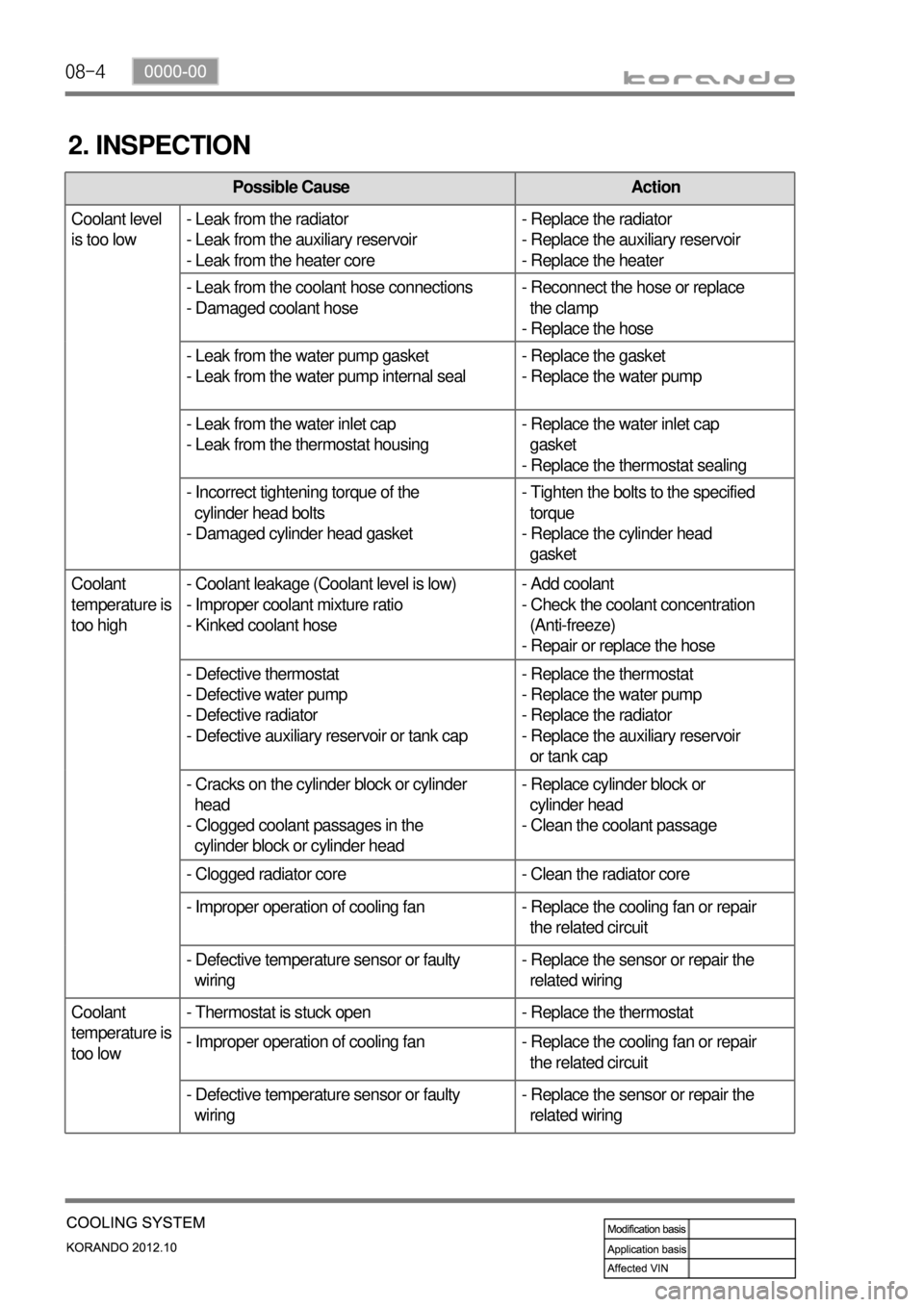
08-4
2. INSPECTION
Possible Cause Action
Coolant level
is too low- Leak from the radiator
- Leak from the auxiliary reservoir
- Leak from the heater core- Replace the radiator
- Replace the auxiliary reservoir
- Replace the heater
- Leak from the coolant hose connections
- Damaged coolant hose- Reconnect the hose or replace
the clamp
- Replace the hose
- Leak from the water pump gasket
- Leak from the water pump internal seal- Replace the gasket
- Replace the water pump
- Leak from the water inlet cap
- Leak from the thermostat housing- Replace the water inlet cap
gasket
- Replace the thermostat sealing
- Incorrect tightening torque of the
cylinder head bolts
- Damaged cylinder head gasket- Tighten the bolts to the specified
torque
- Replace the cylinder head
gasket
Coolant
temperature is
too high- Coolant leakage (Coolant level is low)
- Improper coolant mixture ratio
- Kinked coolant hose- Add coolant
- Check the coolant concentration
(Anti-freeze)
- Repair or replace the hose
- Defective thermostat
- Defective water pump
- Defective radiator
- Defective auxiliary reservoir or tank cap- Replace the thermostat
- Replace the water pump
- Replace the radiator
- Replace the auxiliary reservoir
or tank cap
- Cracks on the cylinder block or cylinder
head
- Clogged coolant passages in the
cylinder block or cylinder head- Replace cylinder block or
cylinder head
- Clean the coolant passage
- Clogged radiator core - Clean the radiator core
- Improper operation of cooling fan - Replace the cooling fan or repair
the related circuit
- Defective temperature sensor or faulty
wiring- Replace the sensor or repair the
related wiring
Coolant
temperature is
too low- Thermostat is stuck open - Replace the thermostat
- Improper operation of cooling fan - Replace the cooling fan or repair
the related circuit
- Defective temperature sensor or faulty
wiring- Replace the sensor or repair the
related wiring
Page 209 of 1082
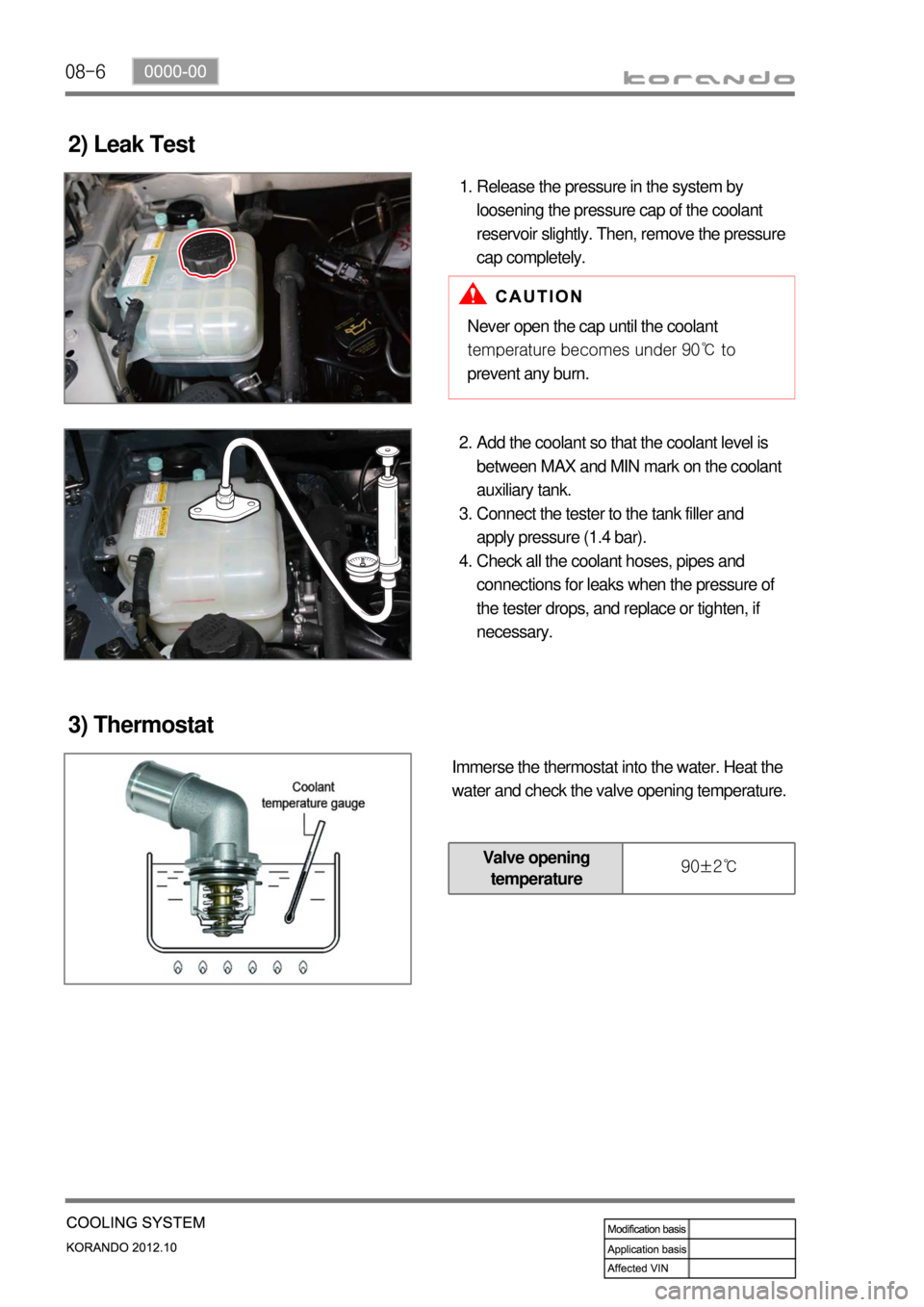
08-6
2) Leak Test
Release the pressure in the system by
loosening the pressure cap of the coolant
reservoir slightly. Then, remove the pressure
cap completely. 1.
Never open the cap until the coolant
temperature becomes under 90℃ to
prevent any burn.
Add the coolant so that the coolant level is
between MAX and MIN mark on the coolant
auxiliary tank.
Connect the tester to the tank filler and
apply pressure (1.4 bar).
Check all the coolant hoses, pipes and
connections for leaks when the pressure of
the tester drops, and replace or tighten, if
necessary. 2.
3.
4.
3) Thermostat
Immerse the thermostat into the water. Heat the
water and check the valve opening temperature.
Valve opening
temperature 90±2℃
Page 211 of 1082

08-8
Thermostat
When the engine coolant
reaches 90℃, the thermostat
starts to open (fully open at
100℃) and lets the coolant
flow to the radiator to maintain
the engine temperature.
1. SYSTEM DESCRIPTION
1) Overview
Coolant reservoir
Long life coolant is used.
Water pump
The water pump is driven by the engine drive belt and supplies
the coolant to each area of the engine.
Oil filter module
Water pump pulley Impeller vaneSealing
Page 212 of 1082
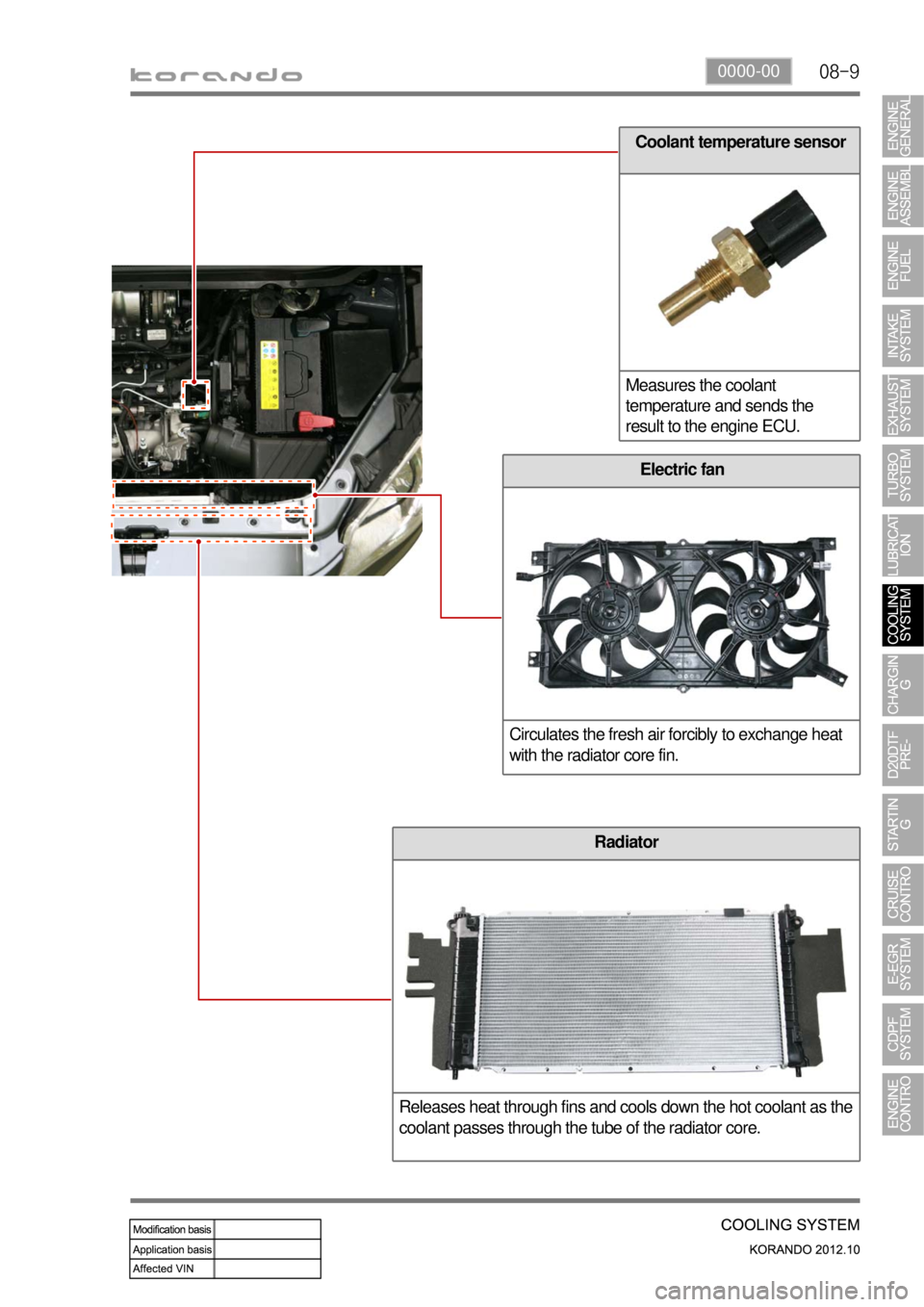
08-90000-00
Coolant temperature sensor
Measures the coolant
temperature and sends the
result to the engine ECU.
Electric fan
Circulates the fresh air forcibly to exchange heat
with the radiator core fin.
Radiator
Releases heat through fins and cools down the hot coolant as the
coolant passes through the tube of the radiator core.